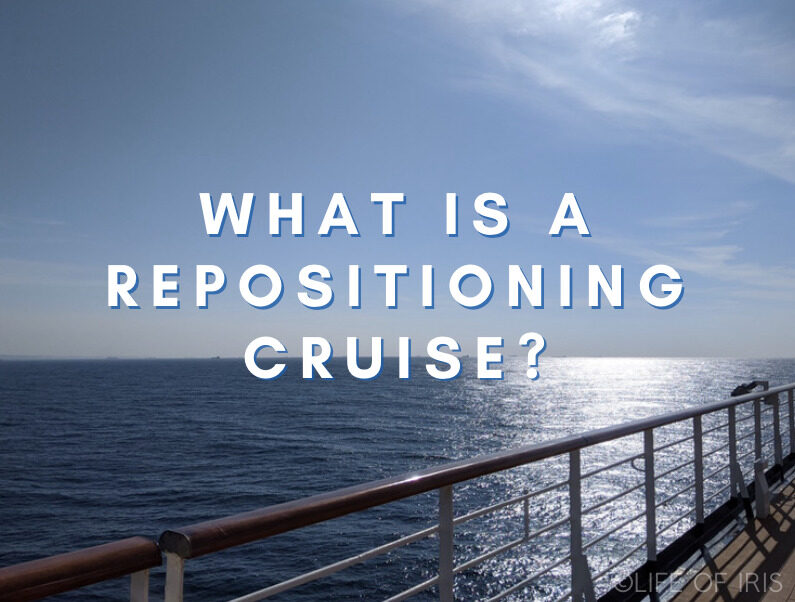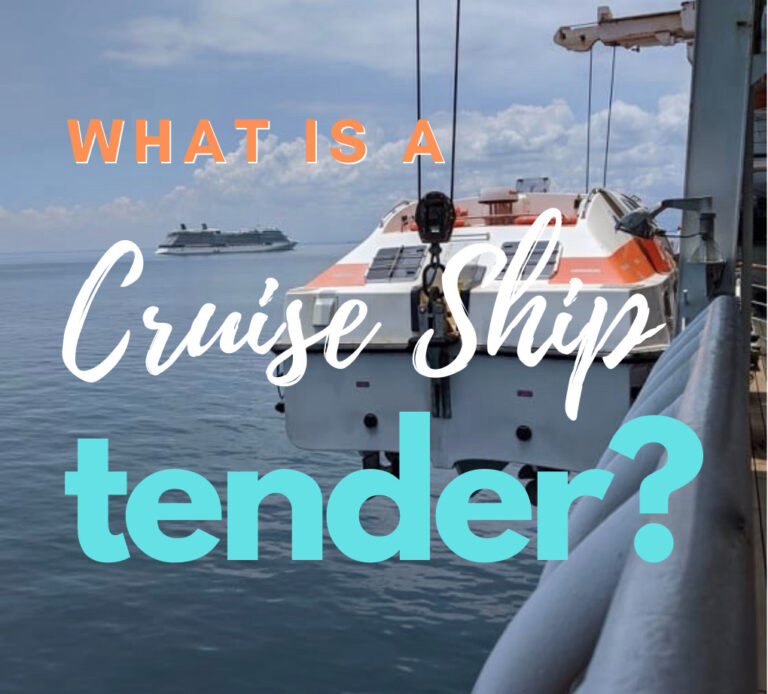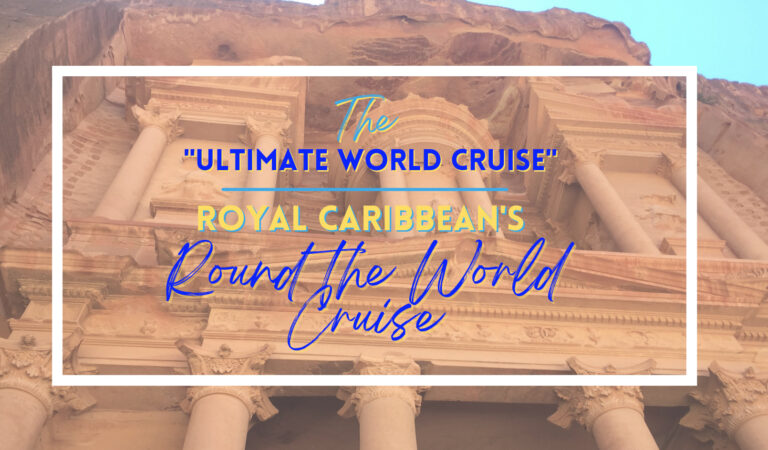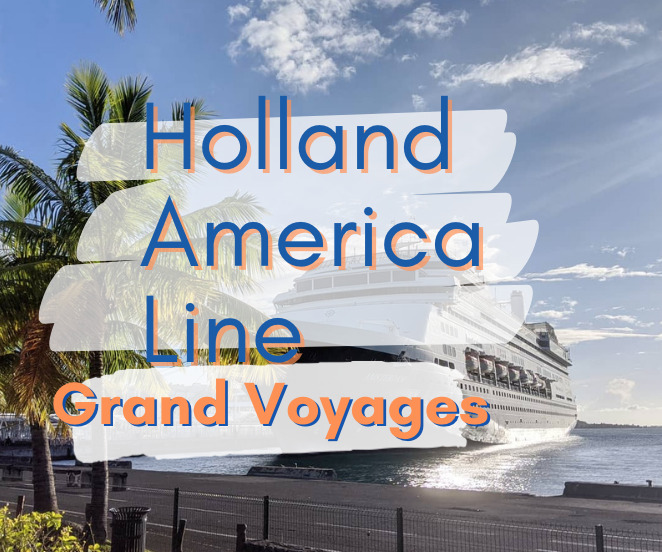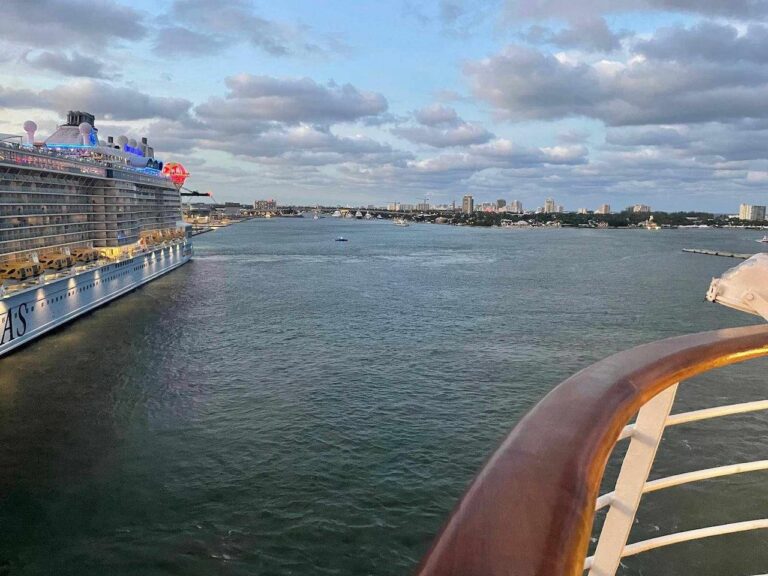What Is A Repositioning Cruise?
Nearly always the best deal in cruising, with prices often less than $50 per person, per day. What is a repositioning cruise?
There are lots of types of repositioning cruises – and I’ve been lucky enough to have been on many. Ranging from crossing the Atlantic to the Panama Canal, the Atlantic Coast or the Pacific Coast, these voyages are one time, one way adventures as ships change move around between seasons.
These one-off or only once-or-twice a year cruises are nearly always a great deal – offering unique itineraries and great prices.
What is a Repositioning Cruise?
To keep it simple – a repositioning cruise is a one-way cruise moving the ship from one region to another for the purpose of its changing seasonal itineraries.
This could be a transatlantic crossing where the ship moves from spending the summer in the Mediterranean to the winter in the Caribbean or it could be a transpacific, or maybe it’s a coastal cruise as a ship shifts from the winter sailing the Mexican Riviera to the summer in Alaska.
“Repositioning cruise” is a name that really applies to lots of different voyages that are all doing the same thing – moving the ships from one region to another.
Best Repositioning Cruises
Here’s a few of the best repositioning cruise deals that I’ve found!
Thinking about a tranatlantic? We’ve got a whole article on the best transatlantic cruises around.
Princess Cruises, Discovery Princess – Pacific Coastal
⭐ $66 per night for a balcony stateroom!! ⭐
Los Angeles, California ➡️ Vancouver, Canada
✅ April 26, 2025, 4 nights, $264 per person (balcony)
Norwegian Cruise Line, Norwegian Epic – Transatlantic
Lisbon, Portugal ➡️ San Juan, Puerto Rico
✅ November 13th, 2025, 10 nights, $543 per person
Carnival Cruise Line, Carnival Dream, Transatlantic
⭐ Less than $50 per night!!!⭐
Barcelona, Spain ➡️ Galveston, Texas
✅ March 21st, 2026, 15 nights, $704 per person
Where Do Repositioning Cruises Go?
Repositioning cruises go pretty much everywhere! Because they are used to bring ships from one region to another you can find a repositioning cruise to many different parts of the world.
Arguably the most common repositioning cruise is a transatlantic between Florida and Europe. There are also repositioning cruises offered across the Pacific ocean, through the Panama Canal, along the Pacific Coast of the US, or heading from the south-eastern United States (think Florida) and heading up to Canada/New England.
Here are the most common repositioning cruise regions:
| Region | Common Embarkation | Common Disembarkation Ports |
|---|---|---|
| Transatlantic | Europe – Barcelona, Southampton, Amsterdam, Lisbon, New York | Florida Ports, Boston/New York, Caribbean, South America |
| Transpacific | Vancouver, Seattle, San Diego, Los Angeles | Tokyo, Sydney, Auckland, Singapore |
| Panama Canal | Vancouver, Seattle, San Diego, Los Angeles | Florida Ports |
| Pacific Coastal | Vancouver | San Diego, Los Angeles |
| Atlantic Coast | Montreal, Quebec City | Florida Ports |
✅ Shop Repositioning Cruises by Clicking Here
What time of year do cruise ships reposition?
Most of the time repositioning cruises happen between late March to early May and October and November in the fall. This is pretty consistent year after year based on seasonality of regions as well as big vacation times.
Cruise lines want to get the most out of a region that they can, especially those regions that ships typically do not sail to certain times of the year. There is some consideration as well for big vacation weeks. An example would be a transatlantic cruise returning to Florida in November in time for a Thanksgiving cruise.
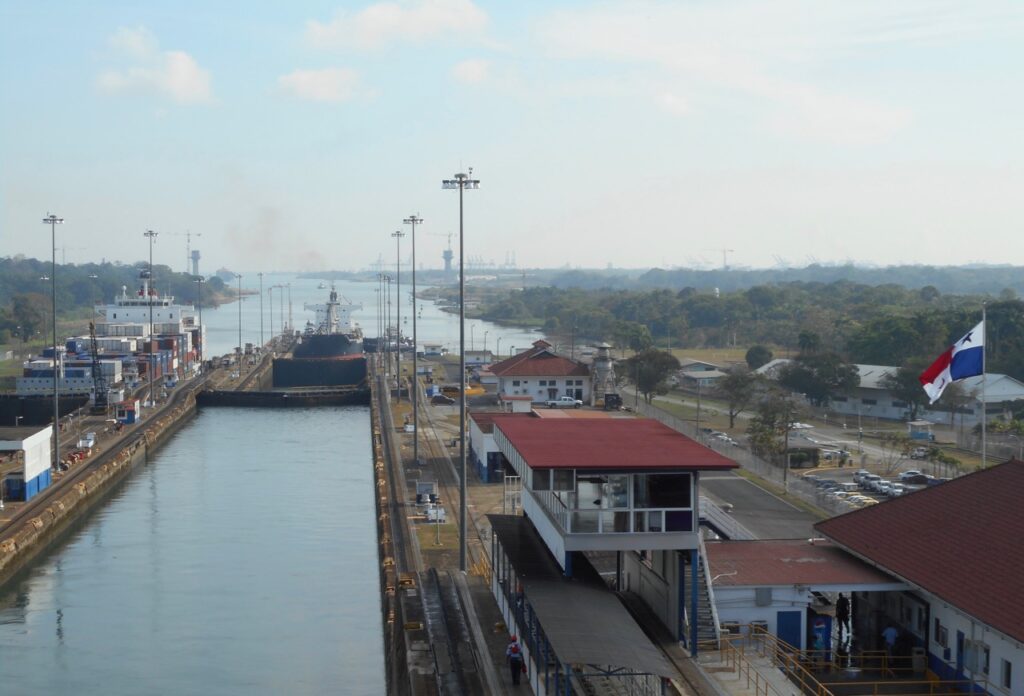
How long are repositioning cruises?
Repositioning cruises tend to be at least 10 days in length with the exception being a Pacific Coastal which may be as short as 4 nights. It’s very, very easy to find repositioning cruises that are much longer than 10 days, too.
Crossing oceans or sailing from one side of a continent to another it takes some time. Plus, cruise lines know that while being onboard is a vacation in itself, people cruise to see the world, so there are days in port on repositioning cruises as well making them a bit longer.
Are repositioning cruises cheaper?
Most of the time they are cheaper per day than most any cruise of the year.
As these cruises tend to be between seasons, are a bit longer, and often have quite a few sea days they can be an incredible deal! Sometimes it’s a last minute deal, but there are definitely some bargains to be had.
Take for instance this Royal Caribbean cruise on Allure of the Seas in 2025. This is one of Royal Caribbean’s newest ships, and a 13 day sailing is starting at $796 or about $61 per person/per day. Compare that to the next cheapest cruise on Allure of the Seas at $646 per person for a 6 night cruise at $107 per person/per night you can see the huge value of a repositioning cruise.
That’s just one example – you can find repositioning cruises ranging from $30 per person/per day but most will be between $50 and $60 per person/per day.
The bigger expense often with these repositioning cruises is the airfare. One way flights can be more expensive and many of these cruises will result in at least one international flight. The cruise fare; however, is typically very inexpensive.
✅ Shop Repositioning Cruises by Clicking Here
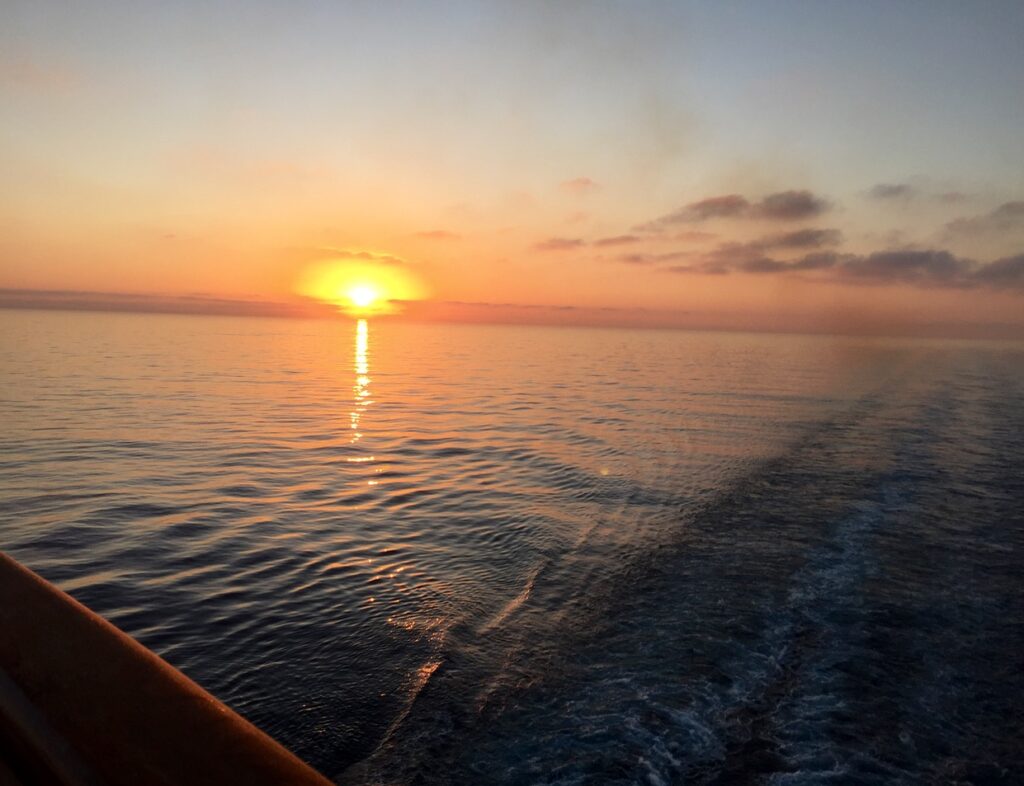
FAQ’s
How does a repositioning cruise work?
As the ships need to go where the passengers want to sail, they have to change regions every once in awhile. The purpose of a repositioning cruise is to move the ship from one region to another. There are sometimes cruises throughout the year that will operate similar itineraries to these repositioning cruises.
The difference here is that one ship is offering that itinerary regularly, back and forth, and the other ship is offering it for the purpose of moving the ship from one region to another.
These cruises are not often called a “repositioning” cruise in the cruise brochures and online. Typically they are listed under the region they are sailing. For instance, there are ships that will sail through the Panama Canal for an entire season, going back and forth from Fort Lauderdale to San Diego and then back again.
Those are not a repositioning cruise because the ship is not repositioning from one region to another, but rather the region that ship is based in for that season (most likely winter) is the Panama Canal – it just happens to be one way itineraries rather than round-trip.

What Are the Typical Seasons for Different Cruise Regions?*
| Region | Season |
| Alaska | late April – September/October |
| Canada/New England | late April – early October |
| Mediterranean | mid-March through mid-November |
| Baltic | mid-April through October |
| Caribbean | Year round for some ships; however, cruise lines often take their ships out of the Caribbean to go to other regions |
| Asia | mid-October through April |
| Australia/New Zealand | mid-October through April |
Are Repositioning Cruises Less Crowded?
By nature that these voyages tend to be outside of busy school vacation weeks and because they are slightly longer they will nearly always be less crowded than a typical cruise.
When you look at the passenger capacity of a ship, it will often show it to you listed either as “based on double occupancy” or for “lower berths”. This number does not take into account the third and fourth passengers (often kids) that can be accommodated in some staterooms.
This could make a repositioning cruise on a ship that often has a lot of kids onboard – like Royal Caribbean’s Oasis class – quite appealing as the ship will likely have a lot less third and fourth berths occupied meaning the ship overall will be less crowded.
✅ Shop Repositioning Cruises by Clicking Here

Can I Add Another Cruise onto a Repositioning Cruise?
A great way to get the most out of a repositioning cruise is to add a cruise on either to the beginning or end of it. Cruise lines have different names for this, but nearly all of them will allow you to sail back to back either on the same ship or even switch ships when you get to a specific port.
An example of this would be flying to Europe in the fall, enjoying a cruise around the Mediterranean and then taking the repositioning transatlantic cruise to Florida. This would give you a chance to explore the Mediterranean region and then enjoy the relaxation of a transatlantic cruise.
The bonus of this of course is if you are from the United States you only have to take one long-haul international flight while still having spent a lovely holiday in the Med.
What is the difference between a regular cruise and a repositioning cruise?
Most cruise lines will have ships spending a “season” or 4-5 months in a specific region of the world. Often once a ship gets to that region it will have a homeport that it goes to regularly to start and end a voyage and will operate repeating itineraries.
A repositioning cruise is not a repeating itinerary, but instead a completely different itinerary usually only offered once or maybe twice a year.
Operationally these cruises are the same as a regular cruise – although sometimes on voyages with crossings and lots of sea days there will be additional entertainment and activities brought onboard.
There are also some extra rules when it comes to babies most of the time. You can check out more on that by reading this post about cruising with babies.
There is a bit of a difference for crew. Sea days can be hard for the crew – don’t be surprised if you are on an oceanic crossing and the crew start to seem a bit tired by the end of the crossing. Sea days for most of the crew is more work than a port day.
Want to know why sea days tend to be easier? Take a look at this post going over some of the pros and cons of sea days vs. port days.
✅ Shop Repositioning Cruises by Clicking Here
Why Do Ships Need to Reposition At All?
Cruise lines will create itineraries and assign cruise ships where they think their customers want to go. These locations change throughout the year. This is largely because of weather, but it also has to do with school vacation schedules and what kind of cruise people are looking for at different vacation times.
The weather may seem obvious – cruising to Alaska in the winter, with the cold weather and short daylight hours – is not what most people would find to be a fun or relaxing vacation. Likewise cruising in the Caribbean in the summer – when it is hot, hot, hot, and when it is hot throughout most of the continental United States – is not what some people are looking for in a vacation, either.
School vacations and length of school vacations are also impactful in planning. It is easier for a family to take a cruise in Europe for instance, when at least a full extra day each way needs to be factored in because of flights, when the kids have longer school vacations.
If you’re from the United States, let’s say you’re from New York, it’s New Years and you want to go on a cruise with your family – do you want to go somewhere warm or cold? Going on a one week cruise in the Caribbean – get some fun and sun and unthaw from the harsh winter – will probably be more appealing than a cruise around Europe or a cruise in Alaska.
Both a bit because of the weather but also because of the travel time needed to get there. Some cruises are for exploring, some cruises are for an escape, knowing which cruise should fall when is all part of the logistics of cruising.
Conclusion: What is a repositioning cruise?
It’s just what the name says! It’s a cruise that repositions the ship from one region to another. As these are one-way trips they often come at a steep discount over regular cruises. They’re seasonal in nature and only happen when ships are changing regions between seasons.

